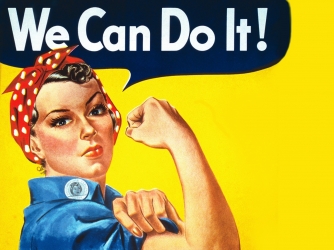Criteria for Working Women During WWII
It’s an article from a July 1943 issue of Transportation magazine, an article written for male supervisors of women who were flooding into the workforce during World War II. Here are some of the suggestions on how to “select the most efficient women available and use them to the best advantage”:“Pick young married women. They usually have more of a sense of responsibility than their unmarried sisters. They’re less likely to be flirtatious, they need the work or they wouldn’t be doing it, they still have the pep and interest to work hard.“When you have to use older women, try to get ones who have worked outside the home before. Older women who have never contacted the public have a hard time adapting and are inclined to be fussy and cantankerous. “General experience indicates that ‘husky’ girls—those who are just a little on the heavy side—are more even-tempered and efficient than their underweight sisters.“Retain a physician to give each woman you hire a special physical examination for female conditions. This step not only protects the property against the possibilities of lawsuit, but reveals any female weaknesses which would make her mentally or physically unfit for the job.“Give the female a definite day-long schedule of duties so that she’ll keep busy without bothering the management for instruction…Women make excellent workers when they have their jobs cut out for them, but they lack initiative in finding work.“Give every girl an adequate number of rest periods during the day. You have to make some allowances for feminine psychology. A girl has more confidence and is more efficient if she can keep her hair tidied, apply fresh lipstick and wash her hands several times a day.“Get enough size variety in operator’s uniforms so that each girl can have a proper fit. This point can’t be stressed too much in keeping women happy.”
“General experience indicates that ‘husky’ girls—those who are just a little on the heavy side—are more even-tempered and efficient than their underweight sisters.“Retain a physician to give each woman you hire a special physical examination for female conditions. This step not only protects the property against the possibilities of lawsuit, but reveals any female weaknesses which would make her mentally or physically unfit for the job.“Give the female a definite day-long schedule of duties so that she’ll keep busy without bothering the management for instruction…Women make excellent workers when they have their jobs cut out for them, but they lack initiative in finding work.“Give every girl an adequate number of rest periods during the day. You have to make some allowances for feminine psychology. A girl has more confidence and is more efficient if she can keep her hair tidied, apply fresh lipstick and wash her hands several times a day.“Get enough size variety in operator’s uniforms so that each girl can have a proper fit. This point can’t be stressed too much in keeping women happy.”

